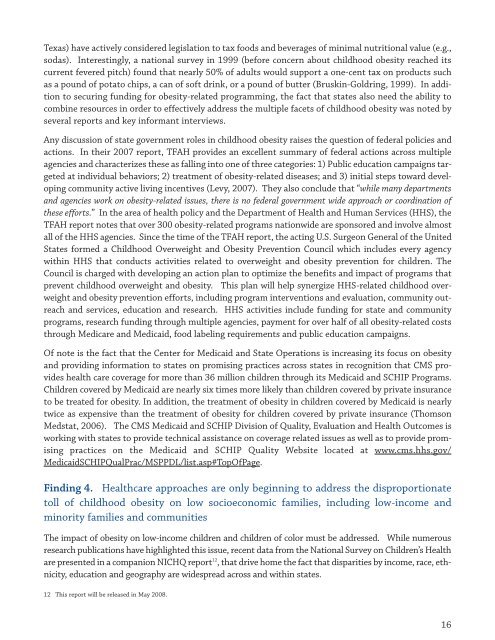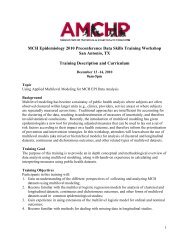Childhood Obesity: The Role of Health Policy - Association of ...
Childhood Obesity: The Role of Health Policy - Association of ...
Childhood Obesity: The Role of Health Policy - Association of ...
You also want an ePaper? Increase the reach of your titles
YUMPU automatically turns print PDFs into web optimized ePapers that Google loves.
Texas) have actively considered legislation to tax foods and beverages <strong>of</strong> minimal nutritional value (e.g.,<br />
sodas). Interestingly, a national survey in 1999 (before concern about childhood obesity reached its<br />
current fevered pitch) found that nearly 50% <strong>of</strong> adults would support a one-cent tax on products such<br />
as a pound <strong>of</strong> potato chips, a can <strong>of</strong> s<strong>of</strong>t drink, or a pound <strong>of</strong> butter (Bruskin-Goldring, 1999). In addition<br />
to securing funding for obesity-related programming, the fact that states also need the ability to<br />
combine resources in order to effectively address the multiple facets <strong>of</strong> childhood obesity was noted by<br />
several reports and key informant interviews.<br />
Any discussion <strong>of</strong> state government roles in childhood obesity raises the question <strong>of</strong> federal policies and<br />
actions. In their 2007 report, TFAH provides an excellent summary <strong>of</strong> federal actions across multiple<br />
agencies and characterizes these as falling into one <strong>of</strong> three categories: 1) Public education campaigns targeted<br />
at individual behaviors; 2) treatment <strong>of</strong> obesity-related diseases; and 3) initial steps toward developing<br />
community active living incentives (Levy, 2007). <strong>The</strong>y also conclude that “while many departments<br />
and agencies work on obesity-related issues, there is no federal government wide approach or coordination <strong>of</strong><br />
these efforts.” In the area <strong>of</strong> health policy and the Department <strong>of</strong> <strong>Health</strong> and Human Services (HHS), the<br />
TFAH report notes that over 300 obesity-related programs nationwide are sponsored and involve almost<br />
all <strong>of</strong> the HHS agencies. Since the time <strong>of</strong> the TFAH report, the acting U.S. Surgeon General <strong>of</strong> the United<br />
States formed a <strong>Childhood</strong> Overweight and <strong>Obesity</strong> Prevention Council which includes every agency<br />
within HHS that conducts activities related to overweight and obesity prevention for children. <strong>The</strong><br />
Council is charged with developing an action plan to optimize the benefits and impact <strong>of</strong> programs that<br />
prevent childhood overweight and obesity. This plan will help synergize HHS-related childhood overweight<br />
and obesity prevention efforts, including program interventions and evaluation, community outreach<br />
and services, education and research. HHS activities include funding for state and community<br />
programs, research funding through multiple agencies, payment for over half <strong>of</strong> all obesity-related costs<br />
through Medicare and Medicaid, food labeling requirements and public education campaigns.<br />
Of note is the fact that the Center for Medicaid and State Operations is increasing its focus on obesity<br />
and providing information to states on promising practices across states in recognition that CMS provides<br />
health care coverage for more than 36 million children through its Medicaid and SCHIP Programs.<br />
Children covered by Medicaid are nearly six times more likely than children covered by private insurance<br />
to be treated for obesity. In addition, the treatment <strong>of</strong> obesity in children covered by Medicaid is nearly<br />
twice as expensive than the treatment <strong>of</strong> obesity for children covered by private insurance (Thomson<br />
Medstat, 2006). <strong>The</strong> CMS Medicaid and SCHIP Division <strong>of</strong> Quality, Evaluation and <strong>Health</strong> Outcomes is<br />
working with states to provide technical assistance on coverage related issues as well as to provide promising<br />
practices on the Medicaid and SCHIP Quality Website located at www.cms.hhs.gov/<br />
MedicaidSCHIPQualPrac/MSPPDL/list.asp#TopOfPage.<br />
Finding 4. <strong>Health</strong>care approaches are only beginning to address the disproportionate<br />
toll <strong>of</strong> childhood obesity on low socioeconomic families, including low-income and<br />
minority families and communities<br />
<strong>The</strong> impact <strong>of</strong> obesity on low-income children and children <strong>of</strong> color must be addressed. While numerous<br />
research publications have highlighted this issue, recent data from the National Survey on Children’s <strong>Health</strong><br />
are presented in a companion NICHQ report 12 , that drive home the fact that disparities by income, race, ethnicity,<br />
education and geography are widespread across and within states.<br />
12 This report will be released in May 2008.<br />
16



